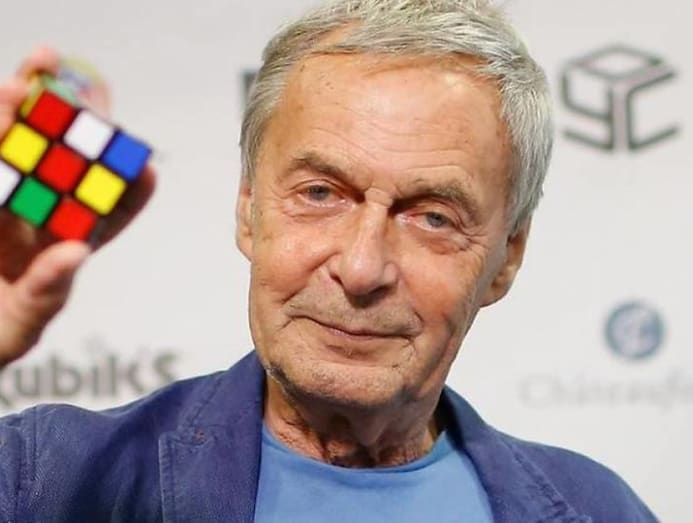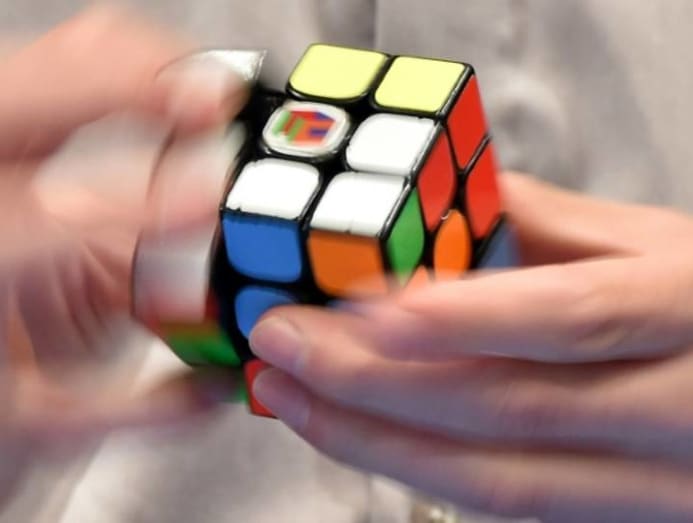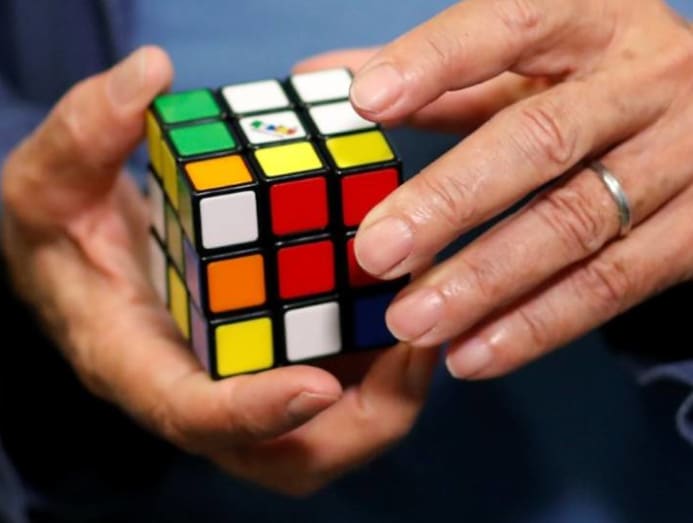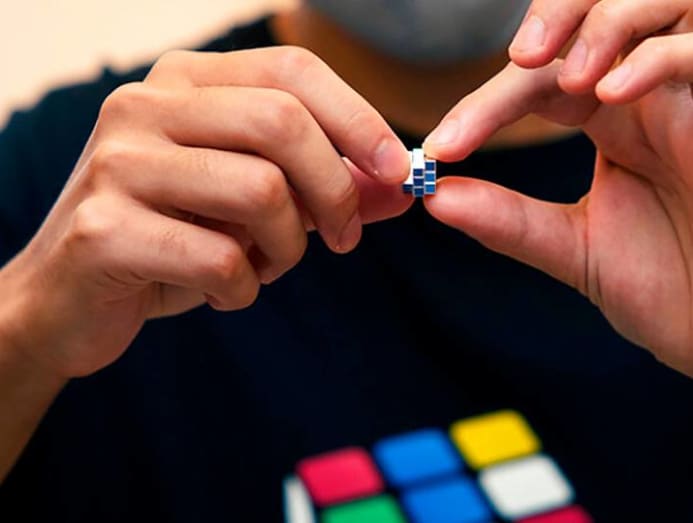‘The Cube has his own voice’: Erno Rubik and the story behind the iconic toy
The Rubik’s Cube creator talks about getting rich in Cold War-era Hungary and why he doesn’t like the term ‘inventing something’.

Erno Rubik, creator of the Rubik's Cube, one of the world's most popular toys of all time. (Photo: AP)
I arrived at the Szepilona Bisztro, on a leafy boulevard on the Buda side of Budapest, clutching a Rubik’s Cube and searching for the man who created it almost 50 years ago.
I felt unworthy to have lunch with Erno Rubik, not least because the Cube I was holding has never been solved. When a waitress approached, I proffered it, explaining that I am dining with its creator. An awed smile spread across her face.
Rubik arrived punctually and without fanfare. The 76-year-old was healthily tanned, his manner by turns boyish and professorial. He’s been coming to this restaurant since the late 1960s, when he was a graduate student, before he invented one of the world’s most successful and brain-busting puzzles – a cube with 43 quintillion combinations, only one of which is correct.
His moment of inspiration came in the spring of 1974, when Rubik was living in his family’s apartment on a grand avenue on the Pest side of the city, which is separated from the hilly Buda side by the Danube. He was a professor of architecture, but his room was “like a child’s pocket, full of marbles and treasures”.
In an attempt to help students grapple with three-dimensional problems, he tried to build a set of cubes that stayed together but could also move independently. Eventually he came up with a six-sided structure with nine interlocking cubes on each side. He painted each side a different colour. But after he had twisted it, he realised that he could not easily return it to its original state.
“It was a more difficult task to find a system to solve it than to create the whole thing,” he said, “probably because I am more familiar with engineering and structure and design than with math.” In the end, it took him a month. And solving it gave him a “euphoric feeling of freedom”, he said at the time.

‘AN ICON OF SOMETHING’
The Rubik’s Cube was born, and to date more than 450m have been sold, the craze reaching its zenith in the early 1980s. Rubik seems genuinely awed at the widespread adoption of his creation.
“Usually an icon has a very specific content – it is an icon of something,” he said. “But the content of the Cube is so wide that it can be an icon of logical thinking, a way of life.” Even today, people fight in global “speedcubing” competitions to shave nanoseconds off the record time for solving the puzzle, which currently stands at 3.47 seconds.
We, meanwhile, were making slow progress with the food. I had been hoping for a three- or four-course traditional meal, which would offer an opportunity to explore Hungarian cuisine beyond goulash and to indulge my affinity for cold fruit soups, but Rubik wasn’t inspired by the menu, so we stuck to mains.
I kept it traditional with a duck confit accompanied by mashed potatoes, slow-cooked cabbage and a side salad. After a digression on the perfect formula for the number and kind of options a menu should contain, articulated as only a puzzle-maker could (the gist: not too many choices but not too few either), Rubik opted for fried chicken strips and a side of pickles.
We were dining at the beginning of uborka (cucumber) season, the slow period when the only thing going on was the cucumber harvest and preparations for pickling. Rubik wanted to see how the restaurant’s pickles compared with his own, although he’s keeping his expectations low: “Unfortunately my wife is a wonderful cook,” he said. “Generally speaking, homemade food is much better.”
HE DOESN’T LIKE THE TERM ‘INVENTING’
Rubik was born towards the end of the second world war to an aircraft engineer father – “not a playful man” – and a poet mother whose “capacity for happiness” he said he inherited. It was just before Hungary was closed off from the west by the Iron Curtain. He loved puzzles as a child, and studied sculpture, architecture and the applied arts before becoming a university lecturer.
He was 29 when he “discovered” the Cube in 1974. He chose the verb carefully. “I don’t like the term ‘inventing something’ because the things are there, you need only to discover their potential,” he said.
“But if you are painting a picture, why not call it an invention? Or if you are making a sculpture, it is a kind of invention! Traditionally invention is connected with patents, and patents are only a really narrow part of creativity.”

Rubik made the first prototype by hand, out of blocks of wood held together by elastic bands. Once he saw how his friends interacted with it, he realised it was more than a teaching tool – that it might be a toy with commercial potential. He patented his creation in 1975, and began selling it three years later in Hungarian stores as the Buvos Kocka, or Magic Cube.
By 1979, Rubik had sold 300,000, and the following year he was offered the chance to take his invention to a toy fair in New York, his first trip outside the eastern bloc. From there, it spread across the world, with some 100m Rubik’s Cubes sold in three years (not to mention tens of millions of knock-offs).
“I can’t imagine a higher hype than it was in the 80s, it was really some kind of epidemic,” he said, smiling at his choice of word. He motioned to my Cube. I was forced to admit that I haven’t solved it yet. Rubik comforted me with a Japanese slogan from the 1980s, coined for a rival game: “A minute to learn and a lifetime to master”.
“It’s very true for the Cube,” he told me with a proud smile. When he used to travel to toy fairs in the early days, he said, his main task was to “reassure people who were interested in the Cube that it was possible to solve it”.
THE WORLD FIXATED ON HIM
I asked how it felt coming home after having been confronted with a totally different political and economic system. “The first question is, ‘what does ‘politics’ mean?’,” he replied. “I am not satisfied with politics on the surface. It can be noisy, but for me what is more important is under the surface . . . how people are living.”
When the Cube became a hit, he said, western journalists wrote wide-eyed accounts of Rubik’s life in a country closed to much of the world. They were fixated on the fact that the man who had invented the world’s most popular toy had gone back to work as an academic, earning the equivalent of €200 (S$323) per month. But that never captured the complexity of life under communism, said Rubik.
“There was some kind of structure, some kind of equalised life standard and so on. At that time you could have a good dinner, enjoy many other things, and discover the world as it is in your radius and your view — and you can be happy.
I don’t like the term ‘inventing something’ because the things are there, you need only to discover their potential.
“If you are lacking something, it can be a problem or it can be a kind of advantage,” he continued. “Because, based on your capacity and your need to do something, you can learn a lot in order to do it.”
The Cubes were initially produced by state-owned factories, and Rubik was able to amass a small fortune from royalties, thanks to Hungary’s economic liberalisation. He shrugged off the idea that he was a millionaire, saying that anyone who owned a house or a car was probably a millionaire too – particularly in Hungarian forints. In October, shortly after our lunch date, the Canadian company Spin Master bought the Rubik’s Cube for US$50m (S$66.77m).
Rubik’s success came more than 20 years after the Soviets had crushed the 1956 Hungarian uprising against Moscow’s rule. By the 1970s, Hungary had gained the reputation of being the “happiest barracks” in the eastern bloc, more liberal than, say, neighbouring Romania or East Germany. Janos Kadar, the country’s leader from 1956 to 1988, promoted the idea of “Goulash Communism,” allowing relative cultural freedom for people who did not try to subvert the one-party state.
Rubik enjoyed extra latitude, having been allowed a special passport enabling travel to the west. He also started two foundations focused on encouraging Hungarian inventors to design and market their products, helping to kickstart entrepreneurialism in the country.
“I got my freedom, that was probably my most important factor of life, to do what I needed,” he said. “It doesn’t mean that I can do everything. It means that I can do what is possible, within the possibilities, and that was good enough. The same thing with money: if you are not satisfied with what you are able to reach, you can be very unhappy.”

I was picking at my duck, which had nice crispy skin and came with a healthy portion of red cabbage and potatoes. Rubik steadily ate his chicken strips, which were crunchy but nothing special. The pickles he ordered on the side, he said diplomatically, were “different” from the ones he brines himself.
BETWEEN DIGITAL AND REAL WORLDS
There are 43,252,003,274,489,856,000 possible positions for the Cube to be in. It took 30 years and a team of researchers with a supercomputer to find what Cube aficionados refer to as “God’s Number”: The number of moves it takes to return a Cube scrambled into any possible configuration to its original state (that number is 20). And two years ago, a deep-learning machine taught itself how to solve the Rubik’s Cube with no human assistance.
Rubik was fascinated by these discoveries. “I believe if we are creating any kind of level of (artificial intelligence), that will mirror the nature of human beings . . . (which comes with) advantages and disadvantages.
“If we look back into the past, most technical progress was based on war and fighting,” he continued. “Later on, if we are thinking about space travel, originally it was based on a game between superpowers. As usual, progress is full of contradictions . . . But I am looking for the positive side and I hope we will survive.”
Rubik is no technophobe – his Cube has a lively online presence, including an Instagram account with 96,000 followers. According to him, humanity’s “actual biggest problem is our fighting with nature. It takes a long time to discover the fact that we are living with nature and we are a joint venture. If nature dies, we don’t exist anymore.”
The Cube is between two big empires: One is the digital world, one is the real one, and the Cube is on the border.
I asked him if he thinks the Cube would have been received differently if it had been created now, in the era of immersive computer games, mobile phones and short attention spans. “I don’t think so,” he said. “The Cube is between two big empires: One is the digital world, one is the real one, and the Cube is on the border,” he said, comparing the precision needed to solve it with writing computer code.
We ordered coffee and agreed to share a dish of turos palacsinta, or cottage cheese pancakes. The conversation turned to politics. The Cube featured on the cover of a recent book about Hungary under its strongman leader Viktor Orban, who returned to power in 2010 and has brought much of the media, administration, higher education and culture under his control. Orban has clashed with Brussels over his nationalist, anti-migration stance, most recently threatening to veto the EU’s €1.8tn budget and recovery package because of a plan to tie disbursement of funds to rule of law benchmarks.

As our meal drew to a close, I was keen to find out what Rubik thought about Orban. “From the 1980s, there were big changes all over the world and naturally in my country as well. A lot of things happened, but not as big as expected,” he said. “It goes more slowly than expected, and it’s very contradictional, this progress, I can say.”
THE CUBE LIKE A CHILD
Most people I met in Budapest seemed to have very strong views about the government. Rubik was more circumspect, perhaps because he had seen not only governments change but an entire system fall. Tentatively, he went on: “In life . . . there are different kinds of activities. It’s fine to have X amount of activity. But is it certain that we need to have X amount of stadiums, and . . . to make such a big difference between different kinds of sports?”
Though his phrasing was characteristically elliptical, Rubik was referring to Orban’s pet project: building stadiums, especially for football. The government recently built a stadium for the national football team in Budapest at a cost of €567m. Orban also built a smaller one in the village he grew up in, using EU funds to link it to a €2m train line. A new handball stadium being built in the capital’s tenth district will be the biggest of its kind in Europe.
Do you feel that politics affects your life, I asked?
“From the beginning, I was independent and I keep that position still today,” he said. “I think that’s my nature.” He picked up the Cube and tinkered with it contemplatively as dessert arrived – a huge portion of pancakes, drowning in vanilla cream sauce. I was glad to be sharing it.
Rubik recently published a book on the rise and enduring power of the world’s most popular puzzle toy. Cubed was less a memoir than a chronicle of Rubik’s evolving relationship with his creation. He even wrote the introduction and conclusion of his book in the voice of the Cube. It’s an unusual authorial approach, I said.
“The Cube has his own voice, which is not the same as mine,” said Rubik. “It’s a very interesting task to know your child, to discover his or her personality, character and so on . . . It is the same with the Cube.”
I noted the Cube, who is now approaching middle age, seemed to have a very positive disposition. “He is happy, he has got no problems,” Rubik smiled.
It is probably because he doesn’t mind being manhandled. According to Rubik, one in seven people in the world has touched a Cube. “The Cube in that sense is really international, not connected with any culture, any religion, any specific way of thinking,” he said. “That’s the reason it is very big.”
The pancake is not bad at all, he said, asking me if I cooked. “The Cube, incidentally, is on the cover of several cookbooks . . . ”
As we said our goodbyes, a young woman rose from the large family table dining next to us. Her 11-year-old brother learned to solve the Cube by watching YouTube videos during lockdown. I snapped a photo of the family with Rubik, before departing with my Cube.
By Valerie Hopkins © 2020 The Financial Times



